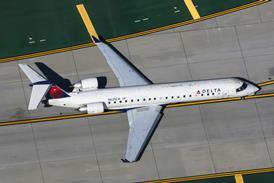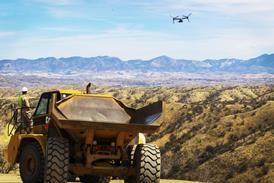Gilbert Sedbon reports on progress on the Superjumbo, the new flagship of the skies
Airbus is riding out the aftermath of 11 September, confident that its A380 superjumbo will ultimately land on a worldwide market in full recovery.


Metal cutting and carbon fibre panelling for the Airbus A380, the world's newest and largest fly-by-wire jet airliner, is well under way. Production plants across Europe, the United States and Asia-Pacific region are preparing major components, systems and other aerostructures for assembly.
A new mammoth hall, dubbed the Aeroconstellation site, has been prepared in Toulouse-Blagnac, Airbus's headquarters in south-west France, for final assembly. Flight testing is to be carried out within three years, with first deliveries of the aircraft in the first quarter of 2006.
Launch
With its A380 order book bulging only a year after the programme's launch, the European builder has embarked on a multi-billion dollar development schedule despite the crisis of confidence that swept through the world's aircraft industry following the terrorist attacks on the US.
Although Airbus, like Boeing, faces several "lean years" – only 300–350 orders for all types of aircraft are expected in 2003 and 2004 across the industry – its strategists are confident that the international air transportation business will bounce back.
They anticipate full recovery, with 5-10% air traffic annual growth, especially in the Asia-Pacific region. Already positive signs are flickering on the horizon, with low-fares carriers leading the way with new orders.
On the eve of Farnborough, Airbus chairman and chief executive Noel Forgeard says: "The Airbus A380 is a reality, on track, on schedule and within budget. Construction is fully under way and first aircraft deliveries begin in March 2006 for entry into commercial service."

At its peak requirement in 2003, the programme will employ 5,000 engineers, backed up by the 50,000-strong Airbus workforce.
Unlike Boeing, which has axed 30,000 jobs after 11 September, Airbus has refrained from swingeing cuts, relying on what Forgeard describes as "flexibility" in his agreements with labour and subcontractors to manage challenges.
"This will preserve the skills and experience of Airbus employees in view of the end of the crisis and recovery in 2004," he says. "Many in the international financial and industrial community are underestimating the capacity of Airbus to meet its objectives, but we'll surprise them all."
With the total programme cost at $10.7 billion, Airbus has signed up more than a hundred risk-sharing participants, partners and large subcontractors covering $2.1 billion of the airframe cost. An additional $900 million is taken by equipment vendors.
Charles Champion, Airbus executive vice-president and A380 programme manager, says the world is at work on the A380. France has responsibility for building the cockpit and the centre wing box, along with final aircraft assembly and flight tests. Britain is constructing the wings. Germany is in charge of fuselage and internal finishing. Spain, a late member of the consortium's four founding partners, has the task of manufacturing the tail surfaces. The list of European, American and Asia-Pacific contractors and subcontractors is impressively long.
Options
Airbus executives say airlines have paid cash deposits on A380 catalogue prices of $230-250 million. This is about $30 million more than a Boeing 747-400, but brings 100 additional seats – not to mention the numerous leisure and recreational options – and a most modern aircraft for the new century.
Eaton Aerospace of Jackson, Mississippi is developing the A380's power generation and fluid conveyance systems, drawing on its experience with high-pressure systems for military aircraft.
The A380 will be the first commercial aircraft to use 35,000kPa (350 bar/5,000lb/in2) hydraulics, compared with 21,000kPa that is standard for airliners and the 28,000kPa on Aerospatiale/BAe Concorde. Using the 35,000kPa hydraulics results in weight savings of around 30% – about 1t on the A380. The higher pressure allows use of smaller hydraulic lines.
The superjumbo will have eight primary engine-driven pumps, plus back-up electric pumps. Eaton will also supply all tubes, hoses and fittings.
Paris-based Thales Avionique and its German subsidiary Diehl Avionik Systeme have won the contract for the avionics systems. They will supply the integrated modular avionics (IMA) and the new cockpit display system (CDS), the sole interface between pilots and aircraft, handling all display and dialogue functions.
The CDS comprises eight liquid-crystal displays (versus six for the previous generation), each with a large 6x8in screen that can display all required information. It also has two ‘mouse' control devices, giving each pilot fast, user-friendly and reliable access to flight data.
As these spherical control devices make the screens effectively interactive for the first time on an Airbus jetliner, the pilot can reconfigure the flight path in seconds, Thales says.
Thales will also provide electronic cabin systems: Airbus flight information system (AFIS) as well as management systems for doors and slides. Other innovative, safe and easy-to-use systems from Thales include secondary flight control, surveillancce system, navigation and flight guidance (FMS, FCU, MMR) and communication (SATCOM, VDR).
A380 bookings are close to 100. Singapore Airlines and Australia's Qantas lead the Asia-Pacific pack, while Air France, Lufthansa and Virgin Atlantic head European carriers. Emirates, the Middle East standard bearer, has the largest single order, and Los Angeles-based ILFC International Leasing Finance Corporation weighs in with orders from the USA.

Though delivery is only four years hence, thorough studies for the future giant aircraft had been going since its concept as the A3XX in the mid-1990s, Airbus officials say. Designed in close collaboration with the world's major airlines, airports and airworthiness authorities, the A380 superjumbo will be powered by new-generation engines, Rolls-Royce's 80,000lbs thrust Trent 900 or General Electric/Pratt &Whitney joint venture Engine Alliance's 72,000lbs thrust GP 7200 engines, according to the client's choice.
Qantas favours the RR Trent 900 while Air France has chosen the Alliance GP72000 engine. A notable American success has been the selection of Goodrich to supply the main landing gear and lateral gear for the A380. Messier-Bugatti, a subsidiary of French aero engine builder Snecma, had previously supplied the main landing gear for all Airbus transports, either alone or in partnership. However, Messier-Bugatti managed to win the A380 nose landing gear, as well as the wheels and the carbon brakes. Aircelle will build the nacelles.
Traffic
Rockwell Collins was chosen to supply the A380's ethernet avionics bus, which will manage data traffic on board the aircraft. The full-digital data bus will have a capacity of 100 Mbps – 10 times faster than that of the 767-400ER and 1,000 times more than the throughput of the ARINC 429 standard data bus on other Airbus aircraft. It was the first standard equipment award for Collins on an Airbus aircraft.
Thales is in charge of IMA advanced Integrated Modular Avionics, common modules, cockpit displays and controls. The French avionics manufacturer decided to tighten its relationship with Airbus by launching development of a Flight Management System (FMS) with Smiths Aerospace and acquiring US supplies of GPS receivers, inflight equipment and TCAS systems.
Thales also kicked off a European research effort aimed at studying advanced Integrated modular avionics (IMA) architecture, with a focus on the A380. Hamilton Sundstrand will supply the air-conditioning systems while Pratt & Whitney Canada will provide the auxiliary power unit (APU) and Aerolec Thales/TRW the electrical power generation.
Other European and American equipment makers include France's Latecoere and Germany's Dielh Avionik Systeme and Lirbherr/Parker.
Australia's Hawker de Havilland is building the wing tips and South Korean Aerospace Industries the wing panels. Japan's Sumitomo supplies metal titanium sheets and Malaysia's CTR the leading edge access panels, while Toray and Toho Tenax provide composite (carbon fibre) parts, and JAMCO supplies the UD floor carbon cross beams, stuffeners and stringers for VTP.
In further efforts to boost the A380's chances and secure a breakthrough on Japan's Boeing-dominated airliner market, Airbus has enlisted leading Japanese aerospace industrialists as participants in the programme. Included in this latest tranche are Mitsubishi Heavy Industries (MHI), Fuji Heavy Industries (FHI) and Japan Aircraft Manufacturing (Nippi), which are taking on work worth an estimated $850 million over the life of the programme.
MHI will make forward and aft lower cargo doors at its factory at Oye in Nagoya. The first batch is due in Toulouse in September next year. FHI will supply leading and trailing edges for the A380's composite vertical stabiliser, plus the fin tip and aerodynamic fairings, produced at the company's Utsunomiya plant, with first deliveries scheduled for next May. Nippi will make horizontal stabiliser tips at its Yokohama plant, with first parts shipped to Toulouse in October next year.
Production rate is set at three aircraft a month, building up in the years after first deliveries. Airbus anticipates that there will be a period of inactivity before a second wave of carriers start to commit to the A380 in around a year's time.
But the manufacturer hopes to make an A380 breakthrough in Japan with a possible order from All Nippon Airways (ANA), already an A320/A321 and A340 customer. Japan Air Lines flag carrier admittedly is a tougher nut to crack.
Forgeard is confident that JAL, a wholly Boeing client, will eventually rally when the A380 goes into commercial service and proves its worth, especially among Asia-Pacific carriers.
Consortium
GE Capital Aviation Services (GECAS), the other American leasing company, is also a major candidate.
British Airways, once one of the most enthusiastic supporters of the project, dealt a heavy blow to the European consortium by saying it does not, for the time being, intend to order the new super Jumbo as it is trying to reduce, rather than increase, capacity on many routes. Forgeard, however, hopes that the British flag carrier will be coming in before long.
The A380 has fought weight growth with new technologies, greater use of carbonfibre and other thermoplastic composites as well as light aluminium alloys and low-fatigue materials, says Robert Lafontan, vice-president engineering and product development.
Whether it does or not Forgeard has no doubt about his big, beautiful baby. He says the A380 will be "the Flagship of the Skies and the 21st century way to fly".
Source: Flight Daily News























